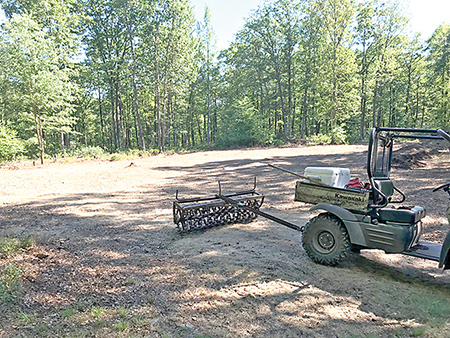Several years ago, a landowner whom I have known for quite some time, approached me about helping him design and develop a food plot. He owns 120 acres, which included 50 acres of open fallow fields, and a wooded area of about 70 acres that stretched up a hillside and across a top, where it bordered other property owners. After cruising the property, and based on the terrain, we decided on a location on the top, in the woods, which would require dropping numerous red oak, chestnut oak, maple, and black birch trees, resulting in an opening of about one acre.
The plot would be oval in shape, with additional trees dropped on the western side to provided added sunlight in the evening hours. Once the trees were dropped and cut for firewood, the remaining tops would be chipped. The huckleberries, mountain laurel, and other brush would be chopped up with a brush hog. That was the plan to create the opening for the food plot.
Work began in early June, over several weekends, as a crew of friends and neighbors joined in to drop the trees and cut and split firewood. The remaining tops were chipped in a process that took about four hours and provided several piles of chips that would decay and be used later for mulching material for any seedlings that might be added to the outside edges of the plot.
Next, the stumps that remained had to be addressed. Old stumps from trees that were cut years earlier were able to be removed with the front end loader of a 50 horsepower tractor, but the fresh tree stumps would not budge. These were trimmed as flush to the ground as possible and then covered with a layer of 46-0-0 nitrogen to expedite the decaying process.
Limbs and logs left over from timbering 15 years earlier were gathered and moved to one large pile at the western end of the clearing, where they would rot down over the years and eventually turn into soil that could be added to the food plot in future years. A small tractor pulling a stone rake was then used to clear the smaller limbs and debris and level the seedbed, as well as fill in the holes created by the stump removal. The landowner had considered piling all of this debris into one huge pile in the center of the plot and burning it, but safety, manpower, and liability issues determined that burning would not be a good alternative.
A soil sample had been taken before the project had begun, and since the existing soil was of poor quality, the landowner had two large loads of topsoil and mushroom soil mix delivered, then spread over the entire area using a tractor with a front-end loader and stone rake. Pelletized nitrogen, phosphorus, potash, and lime were spread and worked in with the use of a 4-foot drag harrow pulled behind a 4-wheeler.
Seeding was done by hand since there was only about an acre to cover. First, buckwheat seed was applied over the entire acre, and then some leftover clover seed was distributed (while it is not the ideal time to apply clover seed, it was a good opportunity to use up the seed). Sugar beet seed and a mix of seeds of chicory, rape, turnips, and brassicas from the Whitetail Institute were added.
As the last step, the entire seedbed was tamped down using an old crow’s foot cultipacker pulled behind the 4-wheeler.
That final step occurred on Monday, July 9, and left only one thing to aid the process of creating a successful food plot — rain. Lo and behold, the very next day, blue skies gave way in the afternoon to thunderstorm clouds that provided 30 minutes of moderate rain that would jump-start the growth of the seeds!





Leave a Comment
Your email address will not be published. Required fields are marked with *